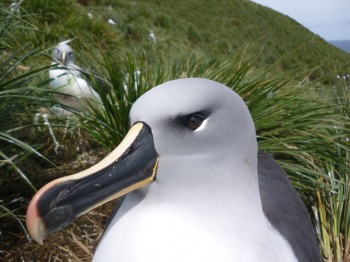
Grey-headed Albatross on Bird Island, South Atlantic, photograph by Richard Phillips
William Mills (British Antarctic Survey, Cambridge, UK) and colleagues have published in the journal Ibis on using stable isotopes to study non‐breeding adult Grey‐headed Albatrosses Thalassarche chrysostoma while at sea.
The paper’s abstract follows:
“The non‐breeding period is critical for restoration of body condition and self‐maintenance in albatrosses, yet detailed information on diet and distribution during this stage of the annual cycle is lacking for many species. Here, we use stable isotope values of body feathers (δ 13C, δ 15N) to infer habitat use and trophic level of non‐breeding adult Grey‐headed Albatrosses Thalassarche chrysostoma (n = 194) from South Georgia. Specifically, we: (i) investigate intrinsic drivers (sex, age, previous breeding outcome) of variation in habitat use and trophic level; (ii) quantify variation among feathers of the same birds; and (iii) examine potential carry‐over effects of habitat use and trophic level during the non‐breeding period on subsequent breeding outcome. In agreement with previous tracking studies, δ 13C values of individual feathers indicate that non‐breeding Grey‐headed Albatrosses from South Georgia foraged across a range of oceanic habitats, but mostly in subantarctic waters, between the Antarctic Polar Front and Subtropical Front. Sex differences were subtle but statistically significant, and overlap in the core isotopic niche areas was high (62%); however, males exhibited slightly lower δ 13C and higher δ 15N values than females, indicating that males forage at higher latitudes and at a higher trophic level. Neither age nor previous breeding outcome influenced stable isotope values, and we found no evidence of carry‐over effects of non‐breeding habitat use or trophic level on subsequent breeding outcome. Repeatability among feathers of the same individual was moderate in δ 13C and low in δ 15N. This cross‐sectional study demonstrates high variability in the foraging and migration strategies of this albatross population.”
Reference:
Mills, W.F., McGill, R.A.R., Cherel, Y., Votier, S.C. & Phillips, R.A. 2020. Stable isotopes demonstrate intraspecific variation in habitat use and trophic level of non‐breeding albatrosses. Ibis doi.org/10.1111/ibi.12874.
John Cooper, ACAP Information Officer, 17 August 2020

 Español
Español  English
English  Français
Français